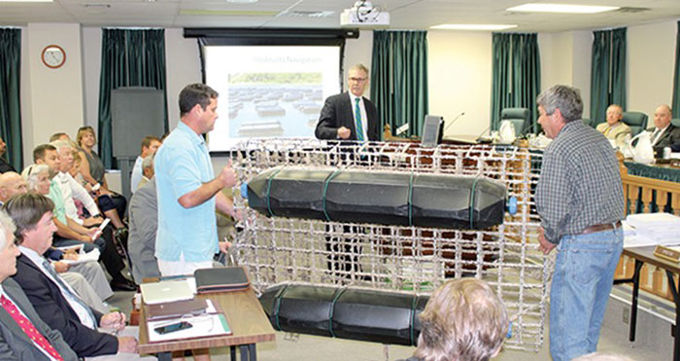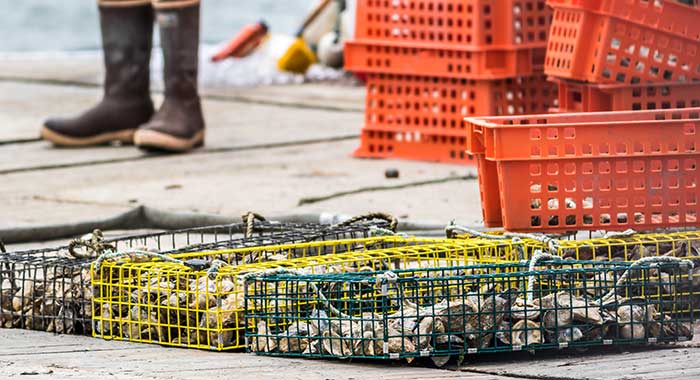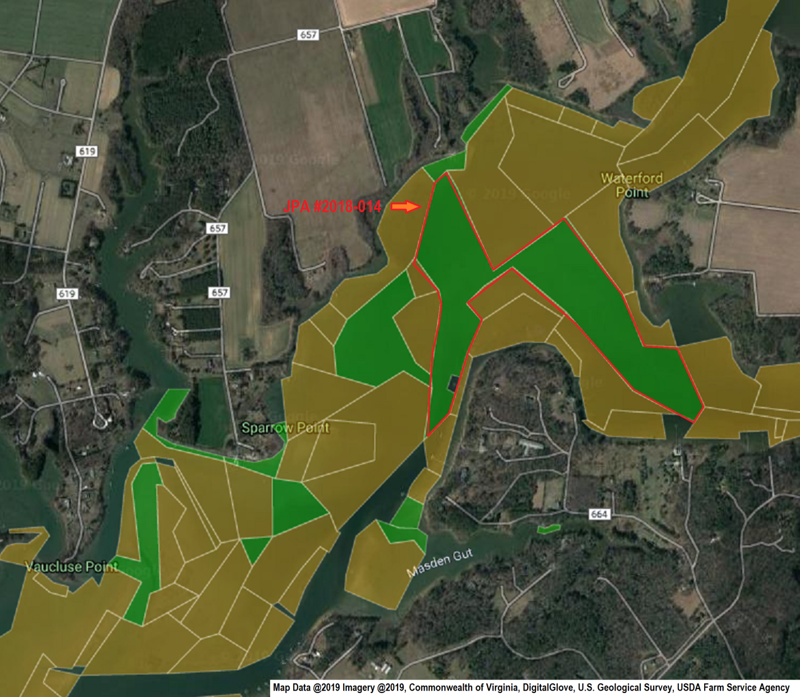
VA Riparian & Waterfront Property Rights at June 2019 VMRC Meeting
“VMRC decisions have direct and immediate consequences affecting the riparian property rights of Virginia's waterfront property owners. The VMRC makes these decisions at monthly meetings which are open to public. We attend the monthly VMRC meetings to represent our clients or as observers, and provide our readers a summary of the important cases.”
The Virginia Marine Resources Commission (VMRC) is the state agency that manages Virginia’s marine resources. The VMRC regulates the fisheries and shellfish industries and issues permits for encroachments over state-owned submerged lands. It also manages the Virginia Wetlands Act, and the Coastal Primary Sand Dune Protection Act. VMRC decisions have direct and immediate consequences affecting the riparian property rights of Virginia's waterfront property owners. The VMRC makes these decisions at monthly meetings which are open to public. We attend the monthly VMRC meeting to represent our clients or as observers, and provide our readers a summary of the important cases.
The June meeting of the Virginia Marine Research Commission was held on June 25, 2019 in the VMRC’s offices located on Fort Monroe in Hampton, Virginia. Seven of the nine commissioners were present: Commissioner Bowman and Associate Commissioners Ballard, Everett, Lusk, Minor, Neill, and Zydron. Associate Commissioners France and Tankard were absent.
After approving the minutes, the Commission took up uncontested infrastructure applications for projects with a cost greater than $500,000.00. “Uncontested” means that no one submitted a written protest to the project. There was only one on the docket, Washington Gas, JPA #19-0133. This project was to cross Opequon Creek and Hot Run in Frederick County with a new, 20-inch natural gas pipeline. The Staff recommended approval with the inclusion of the applicant’s Frac-Out Contingency Plan, implementation of erosion and sediment control measures, and a $345.00 royalty. The Commission unanimously approved the staff recommendation.
Our proprietary data shows that the VMRC approved 100% of the contested infrastructure applications submitted in 2018 and 2019, although some have been ‘after the fact’ approvals accompanied by a monetary fine. Given the high approval rate for contested applications, this uncontested application should almost certainly receive an approval.
The next agenda item was the sole matter on the Consent Agenda, Anne Mepham, JPA #19-0518. This application concerned a request to retain and repair a 5-foot by 13-foot pier, construct a new 5-foot by 35-foot pier with a duel slip open-sided boathouse, and a 12-foot by 32-foot floating dock on the Powhatan Creek in James City County. The Staff noted that the applicant’s husband built the existing pier not knowing he needed a permit. The Staff also noted that multiple piers on a single property were not uncommon in narrow waterways like Powhatan Creek, and recommended approval of the permit with the applicant agreeing to pay a $1,000 fine in lieu of further enforcement of the unpermitted pier construction. The applicant spoke briefly, mentioning the land had been in the family for over 100 years. Our proprietary data shows that the VMRC approved 100% of the contested infrastructure applications submitted in 2018 and 2019, although some have been ‘after the fact’ approvals accompanied by a monetary fine. Given the high approval rate for contested applications, this uncontested application should almost certainly receive an approval. The Commission voted unanimously to approve the Staff recommendation.
The Commission then took up a motion from Association Commissioner Ballard to enter into a closed session for the purposes of conferring with legal counsel concerning litigation matters. After approving the motion unanimously, the commissioners went into a brief closed session. Upon their return, the commissioners unanimously voted to certify that the closed session was for the stated purpose and nothing else other than the stated issue was discussed.

Rabbitti/shutterstock.com
Agenda Item #5, Hunter Webb, Oyster Planting Ground Application #2016-255, was removed from the agenda.
The Commission next heard Kelley L. Parks and Jerry L. Lewis, II, Oyster Planting Ground Application #2018-014. The application was originally for 81 acres of bottomland in Hungars Creek in Northampton County. The applicants, who are siblings, agreed during the approval process to decrease the area of the lease to 57.74 acres by removing acreage that was too deep to use for aquaculture. The application was protested by eight residents who lived on or near Hungars Creek.
The applicants own 10 acres of property on the creek near the lease, and have a small riparian lease there. The applicants were seeking to lease an irregular area in the middle of the creek, situated where it separates into two branches. The lease would take up all of the available unleased land on that part of the creek. Hank Badger, who provides habitat management services for the VMRC on the Eastern Shore, stated that the proposed lease area is usually two to four feet deep during mean low tide and there is no subaqueous vegetation there. He explained that the complaints concerned (1) the fact that the applicants were performing commercial activities in what is a residential area and (2) that the lease would interfere with navigation. Badger stated that commercial activity had been going on in the creek for over a century, so this was nothing new. He also noted that any treats to navigation could be dealt with on an individual basis using the VMRC’s enforcement powers. For these reasons, the Staff recommended approving the lease with the understanding that the Commission may wish to amend the lease to cut out a channel down the middle of the south branch for navigation.

Ms. Parks spoke on her own behalf and described the lease area, the type of aquaculture she and her brother were interested in working on the lease (oysters and claims), and explaining that her father was a waterman and together they had decades of experience working the area waters. She stated that they intended to slowly build the lease with the intent to sell locally. She also stated that there was no defined channel in this part of the creek, so they would not be in anyone’s way. Finally, she pointed out that she and her brother voluntarily decreased the size of their lease because they were worried about impeding access to docks to the south.
Only one protestor spoke at the hearing, Mr. Wayne Galbraith, a waterfront property owner on Hungars Creek who has lived there for 50 years. Mr. Galbraith has two small leases on the creek that he uses for oysters and clams. He claimed that the area of the proposed lease in the southern branch would impede navigation because it was right in the middle of the channel. He stated that another resident had placed pole markers in the creek that routed people right down the middle of the proposed lease and most boaters followed that path. Mr. Galbraith claimed that he attempted to lease the area over a decade ago, but was told by a former commissioner that he would not get it, so he pulled his application. He stated that he had come to understand that the commissioner was right and that this was a bad area to lease because of the threat to navigation. Mr. Galbraith concluded by stating that he was not opposed to the applicants having the lease, as long as it was reduced to allow for an open area of navigation. He suggested that the lease include a 100-foot channel for boaters.
After questions by the Commissioners and a short rebuttal by Ms. Parks, Associate Commissioner Ballard began the discussion by stating that, due to the fact that most tributaries like Hungars Creek were mostly leased, navigation seems to always be an issue. He stated that cutting up the lease to make room for a channel would not work because channels are constantly changing. Ballard pointed out that, as lessees, the applicants would have an incentive to keep obstructions from affecting navigation, and if they failed, the Commission had tools to have the obstructions moved. Finally, he noted that the applicants already demonstrated responsible behavior by reducing the proposed lease acreage when it threatened other dock owners. When he was finished, Dr. Neill moved that the Commission adopt the Staff recommendation and the commissioners approved the motion unanimously.
After the vote, the Commission then unanimously approved a Staff request for public hearing during the July VMRC meeting to take up an amending the regulations to allow for a fee of $150 for the review for oyster planting ground lease renewals.
Finally, the Commission held a public hearing on a number of smaller amendments that pertained to crabbing. The most significant of the four proposed changes concerned raising bushel limits on crabs for November to mirror the earlier months, which would amount to an 8% increase during that month. The second concerned a change to the regulations that would allow individuals who are eligible to obtain a crabbing license, but who do not have such a license, to transfer their eligibility to another without first obtaining a license, as is now required. After a presentation by the Crab Management Committee on how the crab population is improving and a brief comment by a spokesman for the Chesapeake Bay Foundation stating they supported the changes, the Commission voted on each individual change, passing all of them unanimously.
Audio of the meeting is available at http://mrc.virginia.gov/calendar.shtm.
